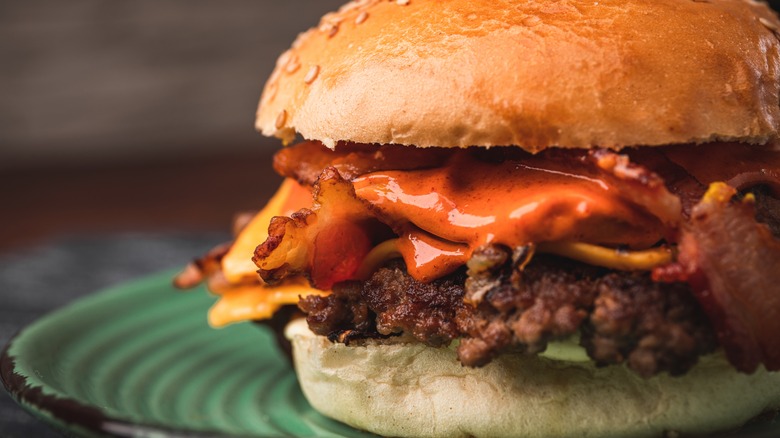A Burger Is, Indeed, A Sandwich
The debate over the definition of a sandwich has raged since people started using the word to describe the 4th Earl of Sandwich's favored snack of sliced meat and bread. The question of whether or not a hot dog can be considered a sandwich has caused controversy for judges no less formidable than Iron Chef's Padma Lakshmi, and the Supreme Court's late, great Ruth Bader Ginsburg. These erudite women of culture both proclaimed on late-night TV that a hot dog is a sandwich — yet people still refuse to acknowledge that burgers, arguably even more sandwich-like than hot dogs, are sandwiches!
According to a 2020 Buzzfeed poll, 56% of people believe that burgers are in a separate food category, with only 37% of respondents recognizing that meat between two slices of bread is considered a sandwich. But how did such a large chunk of the population become so confused? The crucial difference between burgers and sandwiches isn't about the shape, the bun, or the bread. It is subjective. It's about one being associated with work and convenience, while the other is all about fun and freedom.
The origins of sandwiches and their place in the office
Eating meat and bread together is an ancient idea. A sandwich of bitter herbs, sometimes meat, and matzo bread has been part of the Jewish celebration of Passover since the time of Hillel the Elder in the 1st century BC. The sandwich simply got its name because the Earl was a famous politician at the time, and the dish fit in with an aspirational lifestyle in the late 18th century. Historians describe London aristocrats eating sandwiches at the gambling table, at society coffeehouses, or as Sandwich's biographer insists the Earl preferred to eat his sandwiches, hard at work at his desk. In short, sandwiches were eaten in places filled with powerful people doing important things.
People forget that the Earl of Sandwich was in charge of the British Navy during the American Revolution. With hindsight, we know he wasn't a great leader, but at the time he was up against George Washington and John Adams. Knowing the British, naming food after a public figure is just as likely to be a joke as it is a mark of respect. But through its name, this affordable, practical, and delicious dish gained a connection to power and grew to symbolize the kind of modern urbanite who wouldn't stop working, debating, or gambling to eat. Sandwiches are still the most popular working lunch in the UK, with the British sandwich industry estimated to be worth around $10 billion.
Burgers are the American sandwich
Contrastingly, burgers are associated with good times, originally taking off at the St. Louis World's Fair in 1904. An initial flush of success was curtailed by concerns around the meatpacking industry, but by the 1920s, the first hamburger chain, White Castle, opened with a strong message of health and cleanliness. More chains began to open along the emerging highway network, and the burger became central to American life and identity. Fast food symbolized mid-20th century American invention, and later, thanks to advertising, it was associated with cookouts, road trips, and birthday parties. It became a taste of nostalgia — for childhood, the open road, and that lost mid-century Americana.
This explains why people have a subjective disconnect between the sandwich — a flexible snack that gets office workers through the afternoon — and burgers — specifically shaped, slightly sinful, sesame-topped savory cylinders you get en route to camp, on the Fourth of July, or at a fair. But objectively, a burger is two slices of bread with some filling, aka a sandwich.
This doesn't have to be a zero-sum game. Perhaps it is best to think of it like Chef Tom Condron explained to Charlotte Magazine: "A hamburger is a member of the sandwich family, that essentially became so successful that it broke off and began a solo career. [...] A burger is a sandwich — just the most famous one in America."


